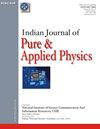Ce和Er掺杂SnO2光催化剂对RB染料的吸附及水处理
IF 1.1
4区 物理与天体物理
Q4 PHYSICS, MULTIDISCIPLINARY
引用次数: 0
摘要
本文主要研究了溶胶-凝胶法制备了纯SnO2纳米粒子和掺铒(Er)和铈(Ce)分别为7%和7%的SnO2纳米粒子。目的是评价其光催化降解有害的孟加拉玫瑰染料的性能。XRD分析证实,未掺杂和掺稀土的SnO2纳米颗粒均表现为四方金红石结构。光致发光(PL)分析表明,随着掺杂剂的增加,氧空位浓度增加。此外,与纯SnO2相比,掺杂SnO2纳米颗粒的带隙减小。带隙的减小主要是由于掺杂剂引起的空位缺陷的产生。光催化实验表明,在紫外光照射60分钟内,掺铒7%的SnO2纳米粒子对粉红染料的降解率达到95.32%。这些发现突出了Er 7%掺杂SnO2作为大规模降解工业废物,特别是有机染料的高效催化剂的潜力。本文章由计算机程序翻译,如有差异,请以英文原文为准。
Adsorption of RB dye by Ce and Er Doped SnO2 Photocatalysts for Water Remediation
This study focuses on synthesis of pure SnO2 nanoparticles and SnO2 nanoparticles doped with Erbium (Er) at 7% and Cerium (Ce) at 7% using sol-gel method. The aim was to evaluate their photocatalytic performance in degrading the harmful Rose bengal dye. XRD analysis confirmed that both undoped and rare earth-doped SnO2 nanoparticles exhibited a tetragonal rutile structure. Photoluminescence (PL) analysis revealed an increase in oxygen vacancy concentration with higher dopant incorporation. Furthermore, band gap of doped SnO2 nanoparticles was reduced compared to pure SnO2. The reduction in the band gap was primarily attributed to creation of vacancy defects caused by dopants. Photocatalytic experiments demonstrated that within 60 minutes of UV light exposure, Er 7% doped SnO2 nanoparticles achieved the degradation of 95.32% of Rose bengal dye. These findings highlight the potential of Er 7% doped SnO2 as a highly effective catalyst for large-scale degradation of industrial waste, specifically organic dyes.
求助全文
通过发布文献求助,成功后即可免费获取论文全文。
去求助
来源期刊
CiteScore
1.30
自引率
14.30%
发文量
42
审稿时长
7 months
期刊介绍:
Started in 1963, this journal publishes Original Research Contribution as full papers, notes and reviews on classical and quantum physics, relativity and gravitation; statistical physics and thermodynamics; specific instrumentation and techniques of general use in physics, elementary particles and fields, nuclear physics, atomic and molecular physics, fundamental area of phenomenology, optics, acoustics and fluid dynamics, plasmas and electric discharges, condensed matter-structural, mechanical and thermal properties, electronic, structure, electrical, magnetic and optical properties, cross-disciplinary physics and related areas of science and technology, geophysics, astrophysics and astronomy. It also includes latest findings in the subject under News Scan.

 求助内容:
求助内容: 应助结果提醒方式:
应助结果提醒方式:


